Rhode Island is a state in New England with a humic continental climate characterized by four distinct seasons. The winters are cold and can be snowy, while summers are warm and humid. This can cause a challenge for gardeners in deciding which flowers to plant in their gardens to get the most beautiful blooms year after year. With these factors in mind, what are some of the best perennial flowers for Rhode Island gardeners?
Following a few key pieces of sage advice can give you the knowledge you need to succeed in growing a gorgeous garden from year to year. For example, choosing plants native to Rhode Island and the neighboring New England states can give you a leg up and a greater likelihood of success in having a thriving garden. You could also look for perennial plants bred and successfully grown in Rhode Island for years. With this advice in mind, what are some of the best perennial flowers for Rhode Island? This article lists seven perennial flowers that many gardeners have successfully cultivated in Rhode Island gardens for years. Keep reading to discover these perennials and what makes them thrive so that you too can grow an incredible garden full of blooms!

About Rhode Island’s Climate
Rhode Island’s climate typically falls within USDA Hardiness Zones 5b to 7a. This indicates that the state experiences very cold winters and mild or moderately hot summers. It is important to keep this climate in mind and choose flowers that can survive and thrive in these conditions – or plant native flowering plants that already grow in Rhode Island! For example, daylily, red columbine, white wood aster, wild yellow indigo, and Carolina roses are all Rhode Island natives. These flowers flourish in this part of the United States and might easily thrive in your garden. Beyond these, there are numerous other low-maintenance flowering plants that grow well in the northeast and could be an easy-to-grow, beautiful addition to your landscape.
A few factors for Rhode Island gardeners to consider are the average rainfall, the drainage of the soil, and the impact that too much moisture can have on plants (contributing to the presence of rot or fungal diseases). With that in mind, let’s dive into seven flowering plants that could be among the best perennial flowers for Rhode Island gardeners to plant this year.
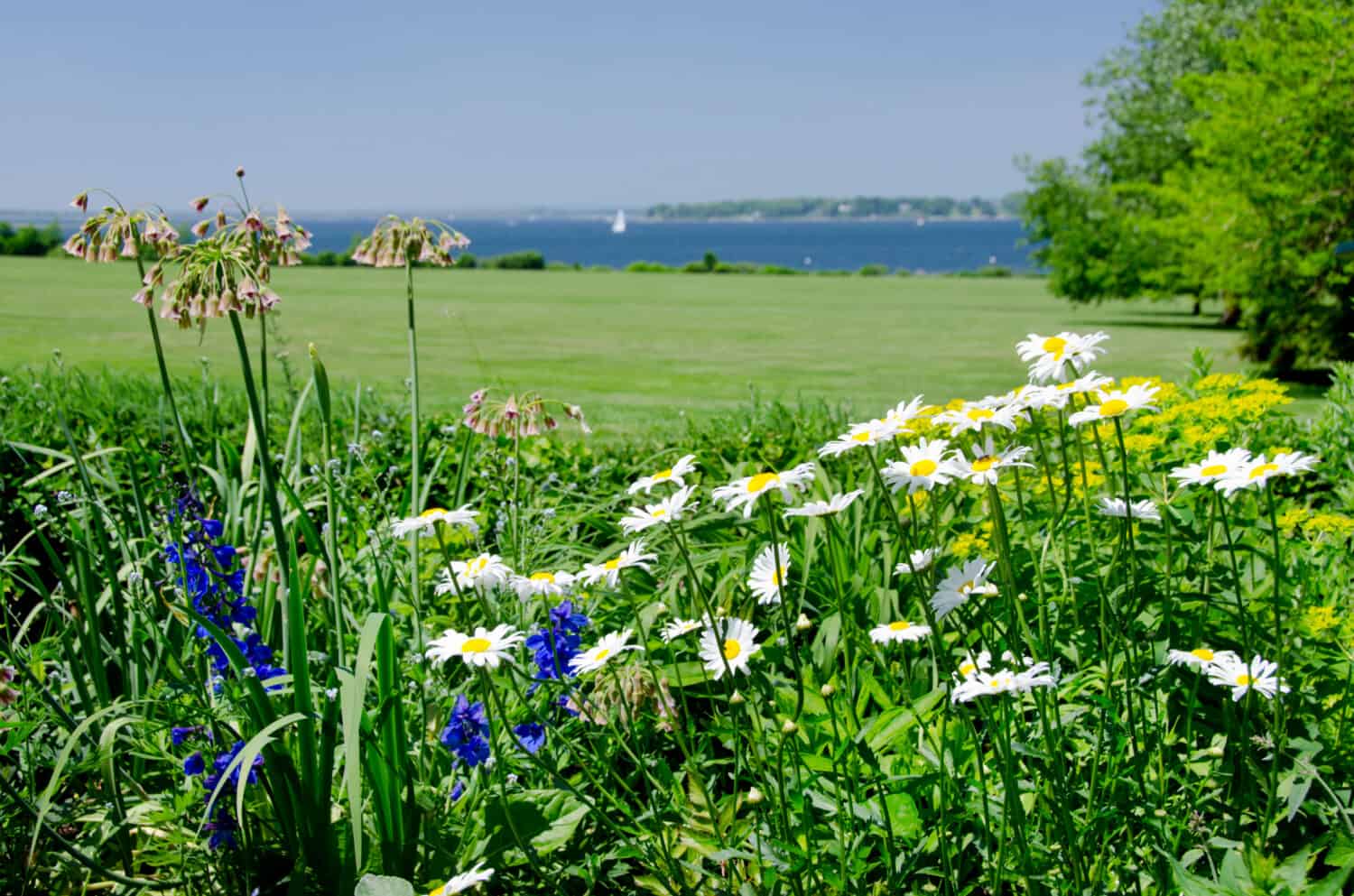
Rhode Island is a state in New England that has a humid, continental climate; four seasons; and beautiful native flowering plants.
©Danita Delimont/Shutterstock.com
Best Perennial Flowers to Plant in Rhode Island
1. Daylilies
Daylilies (Hemerocallis spp.) are a low-maintenance flowering plant that blossoms from spring to fall in USDA Hardiness Zones 4-9. These flowers blossom in vibrant hues of orange, pink, purple, red, white, and yellow, and love full sun. Because they have such a long blooming period and attract beautiful butterfly pollinators, daylilies are a popular choice among gardeners. There are thousands of daylily varieties to choose from when planting your own garden – and they come in a range of sizes, colors, and blooming varieties. Some even flower multiple times from the spring into the fall.
Plant your daylily early in the spring when the soil is tender. You could also choose to plant them in the fall before the first frost of the year. These easy-to-grow plants can survive a range of conditions, but you may find that they grow best in full sun with well-drained soil rich in organic material. Try not to plant the flowers near a tree or shrub, which could take away from the daylily’s ability to capture water and nutrients. Aside from that, daylilies require very little care and attention. Water yours once a week while they get established, add mulch to keep the plant moist, and remove the dead foliage each spring to make room for new growth!
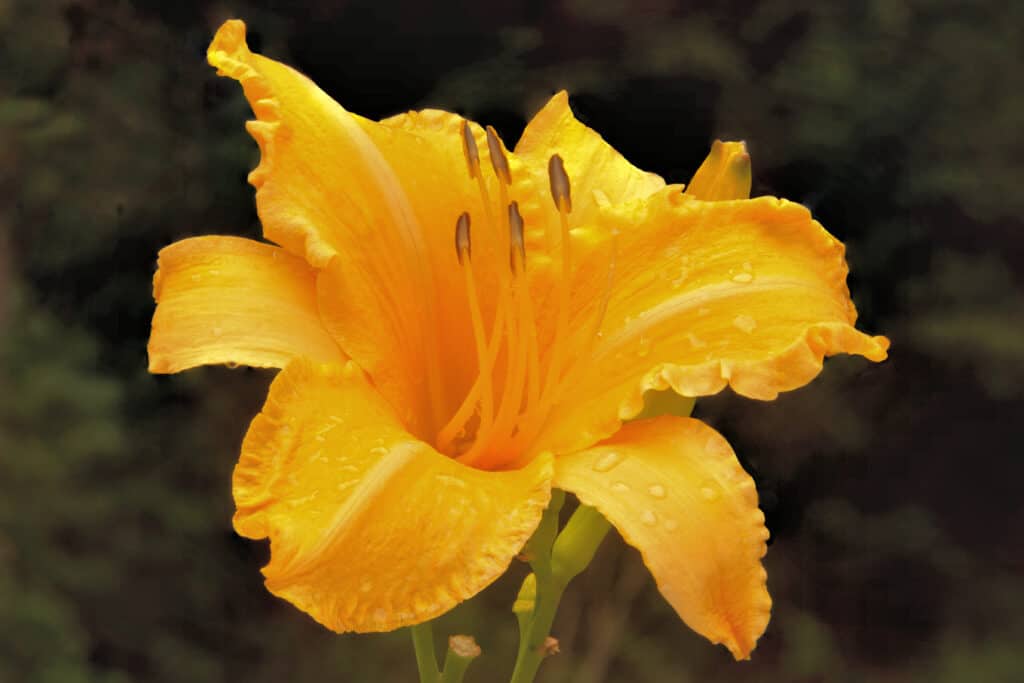
The beautiful Ruffled Apricot daylily blossom (
Hemerocallis) is an award-winning flower with profuse blooms.
©iStock.com/Gerald G Gantar
2. Black-Eyed Susans
The black-eyed Susan (Rudbeckia hirta) is a flowering plant that thrives in USDA Hardiness Zones 3-9 and produces orange, red, and yellow flowers from the summer into the fall. These bright flowers with dark brown centers are members of the family Asteraceae and grow natively in the northeastern corner of the United States, including in New England. Black-eyed susans love the sun and thrive as part of a butterfly garden, border garden, or wildflower landscape.
When looking to plant a black-eyed Susan, make sure you choose the right variety. There are annual, biennial, and perennial varieties. Though these plants are resilient, they grow best in bright sun. However, they will tolerate partial sun. It is very important to not overcrowd them or water their leaves – this can cause deadly fungal diseases. Plant them in the spring after the cold weather has passed and the soil is warm, placing the plants about 18 inches apart. Afterward, check your newly-established plants regularly for watering, to remove dead leaves or flowers, and take away dead plant material.
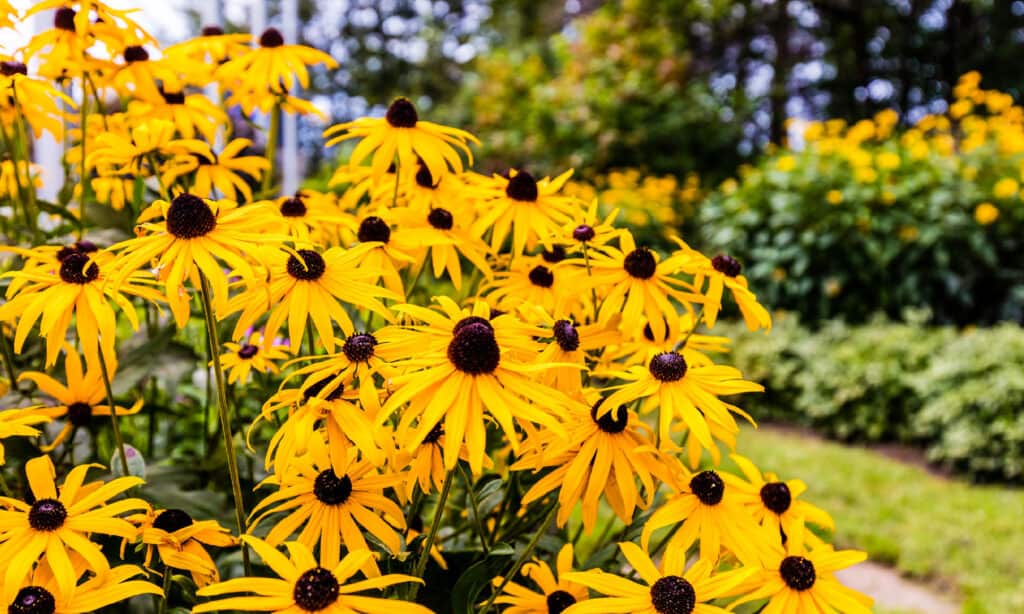
The black-eyed Susan is the state flower of Maryland, but it can also grow well in other northern states, including Rhode Island.
©iStock.com/Dopeyden
3. Coneflowers
Coneflowers (Echinacea spp.) love the sun and come in varieties in a range of colors: green, orange, pink, purple, red, white, and yellow. These flowers blossom each summer into the fall months and thrive best in USDA Hardiness Zones 3-9, attracting birds and butterflies to the garden where they grow. These resilient perennials belong to the Asteraceae family and are native to the eastern and central parts of the United States. The most common variety is the purple coneflower (Echinaceae purpurea), which has bright purple rays that surround a central brown mound.
Coneflowers grow best in full sun with well-draining soil. You can plant them when small, typically from spring into early summer. If starting from seed, you can get the plant growing about 8 to 10 weeks before the last frost of the spring. When you finally plant them in your garden, you can space the plants about 1 to 3 feet apart (depending on the variety), water well, and keep them moist using compost. The new plants should be watered regularly, particularly in dry seasons.
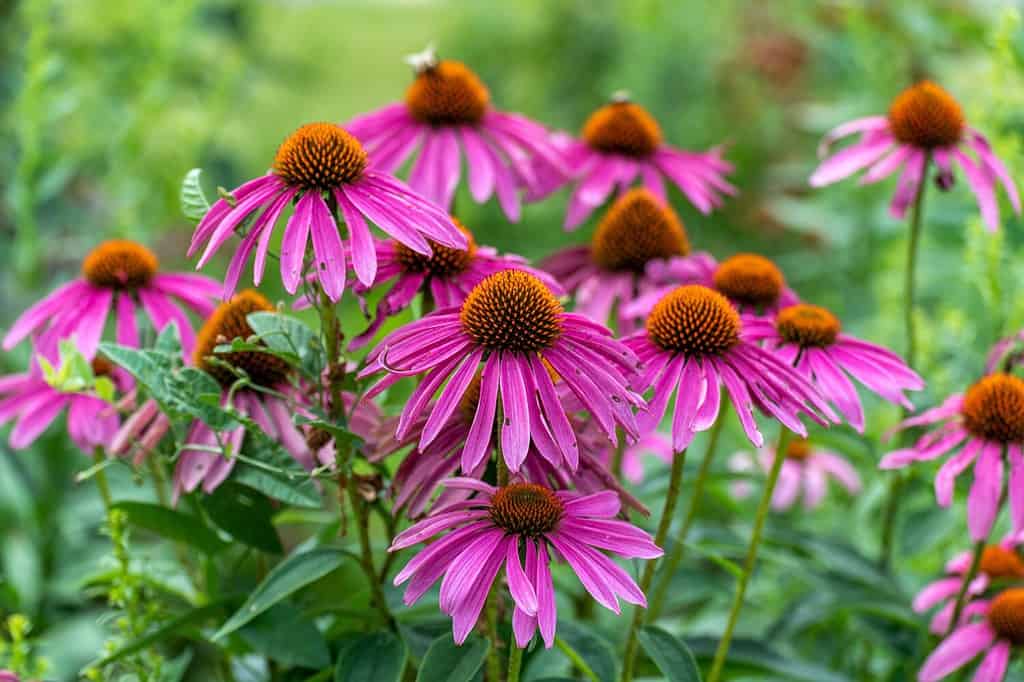
Purple coneflowers can grow to a height of about 47 inches and a width of 10 inches when mature.
©Barbara Smits/Shutterstock.com
4. Coral Bells
“Coral bells” is the common name for multiple species in the Heuchera genus, which encompasses hundreds of different varieties. This perennial is hardy in USDA zones 4a to 9a. Coral bells is a foliage plant that produces small bell-shaped orange, pink, red, or white flowers that bloom in spring and summer, attracting hummingbirds and butterflies with their sweet nectar. Coral bells are fairly easy to grow and do well in semi-shady areas. Plant them either in early spring or the late fall in well-draining, nutrient-rich soil. These plants do not require much maintenance, but you can keep yours blooming by dividing them and cutting them back to allow new growth.

Coral bells, also called Alumroot, have bright flowers and colorful foliage.
©iStock.com/Martina Unbehauen
5. Hostas
Hostas are famous for having beautiful leaves, which can be solid-colored or variegated. However, this long-living perennial plan also produces beautiful flowers that bloom in shades of pink, lavender, blue, and white starting in early summer and lasting into early fall. These lovely blossoms attract hummingbirds and butterflies, which come for the sweet nectar. However, people might also be drawn to hostas for the sweet scent that certain varieties emit. Hostas are hardy to USDA Hardiness Zones 3-8, though some varieties can live in 9 too.
Hostas do well when planted in early spring in moist soil. Plant them in partial sun or dappled shade, though they may live in the shadiest parts of your home lawn or garden too. They grow best in well-draining, fertile soil, but hate to sit in overly-saturated soil. Space your new hosta plants out according to the size that they will reach at maturity. Hostas come in a wide range of varieties, which can grow to great sizes!
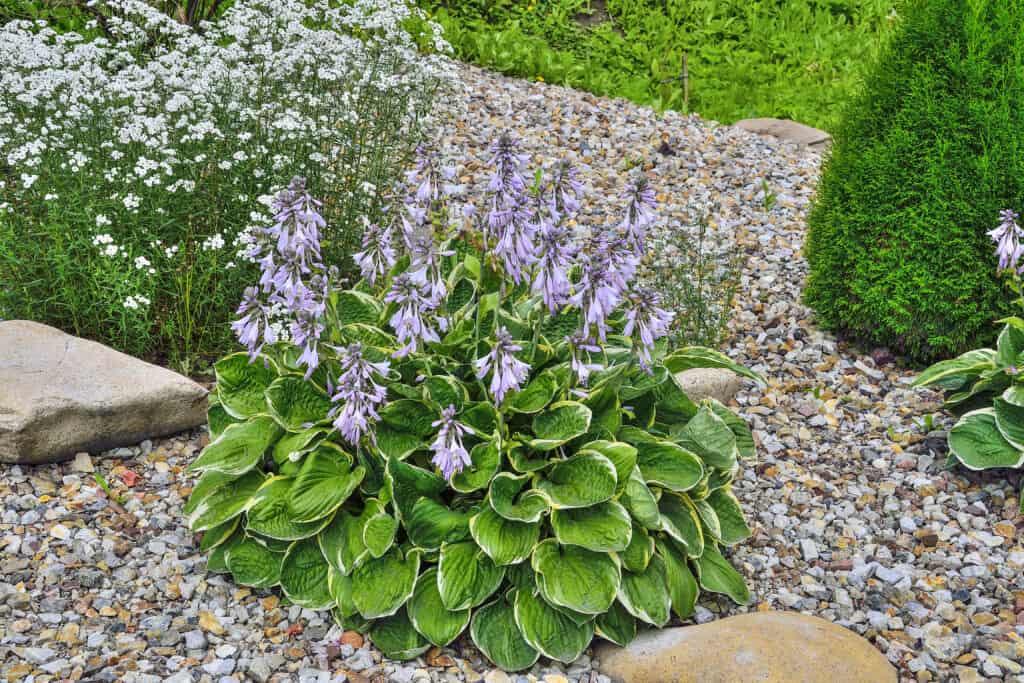
The flowering Hosta Patriot has variegated green and white leaves and delicate lilac flowers.
©iStock.com/Rvo233
6. Peonies
If you love vibrant, large blossoms in the springtime, peonies could be the best pick for your garden. Peonies bloom in late spring, with fluffy flowers ranging in color from whites and pinks to deep red. Peonies thrive in USDA Hardiness Zones 3-9, and grow best in full or partial sun.
These flowers have beautiful foliage. Even beginner gardeners will find that these magnificent flowers are relatively easy to grow and are hardy in states that have cold spring weather. Plant your peonies with stakes that can help to support the weight of their large, heavy flowers. From there, you can enjoy the bright flowers that shine during the spring season before the rest of the summer flowers steal the show.
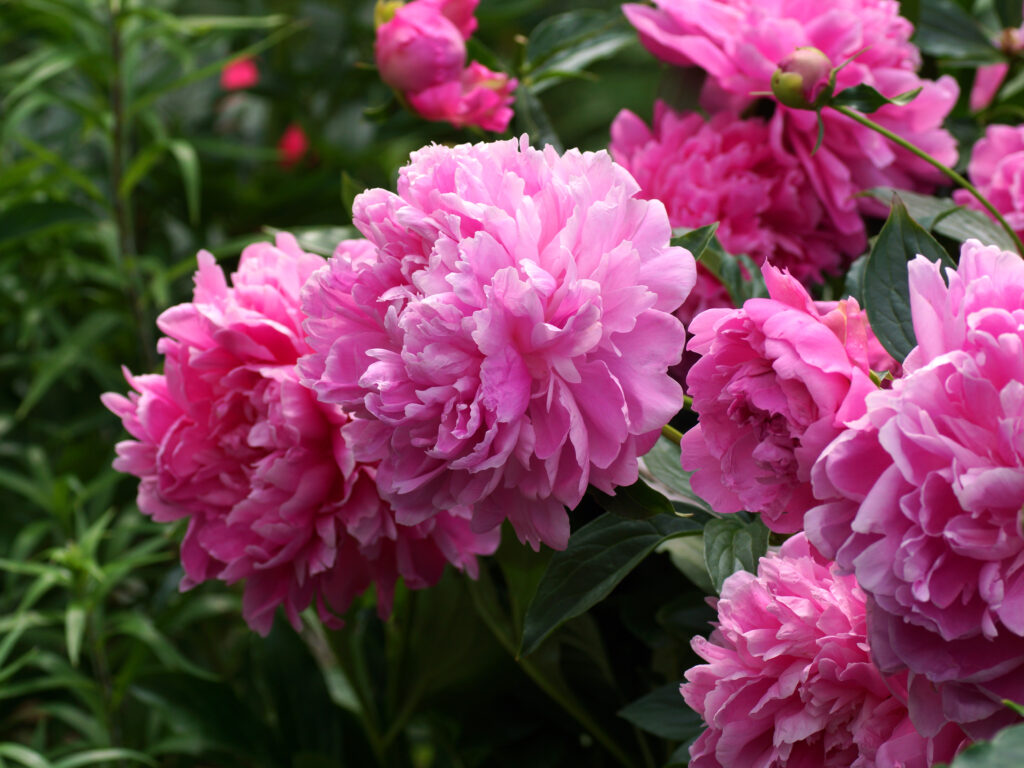
The double-layered petals of peonies give them a full, fluffy, and luxurious look similar to a pom pom.
©Natali22206/Shutterstock.com
7. Red Columbine
Red columbine (Aguilegia canadensis) is one of Rhode Island’s native flowering plants. It grows best in USDA Hardiness Zones 3-8. This member of the Ranunculaceae family grows natively in the northeastern part of the U.S., where it often appears in shallow soil on rock outcroppings or in gravelly oceanside soil. It produces tall erect branches with red and yellow funnel-shaped flowers. These flowers blossom in late spring, attracting pollinators, including bumblebees and hummingbirds. Red columbine offers a pop of color for the shady parts of a home garden. This short-lived perennial pops up in between rocks, by a wall, or in bare soil. If your garden is rocky or sandy, don’t worry!
Red columbine (Aguilegia canadensis) is one of Rhode Island’s native flowering plants. This member of the Ranunculaceae family grows natively in the northeastern part of the U.S., producing tall erect branches with red and yellow funnel-shaped flowers. These flowers blossom in late spring, attracting pollinators, including bumblebees and hummingbirds. Red columbine offers a pop of color for the shady parts of a home garden. This short-lived perennial pops up in between rocks, by a wall, or in bare soil. If your garden is rocky or sandy, don’t worry! Though it grows best in partial shade with well-draining soil, red columbine tolerates a range of soil conditions.
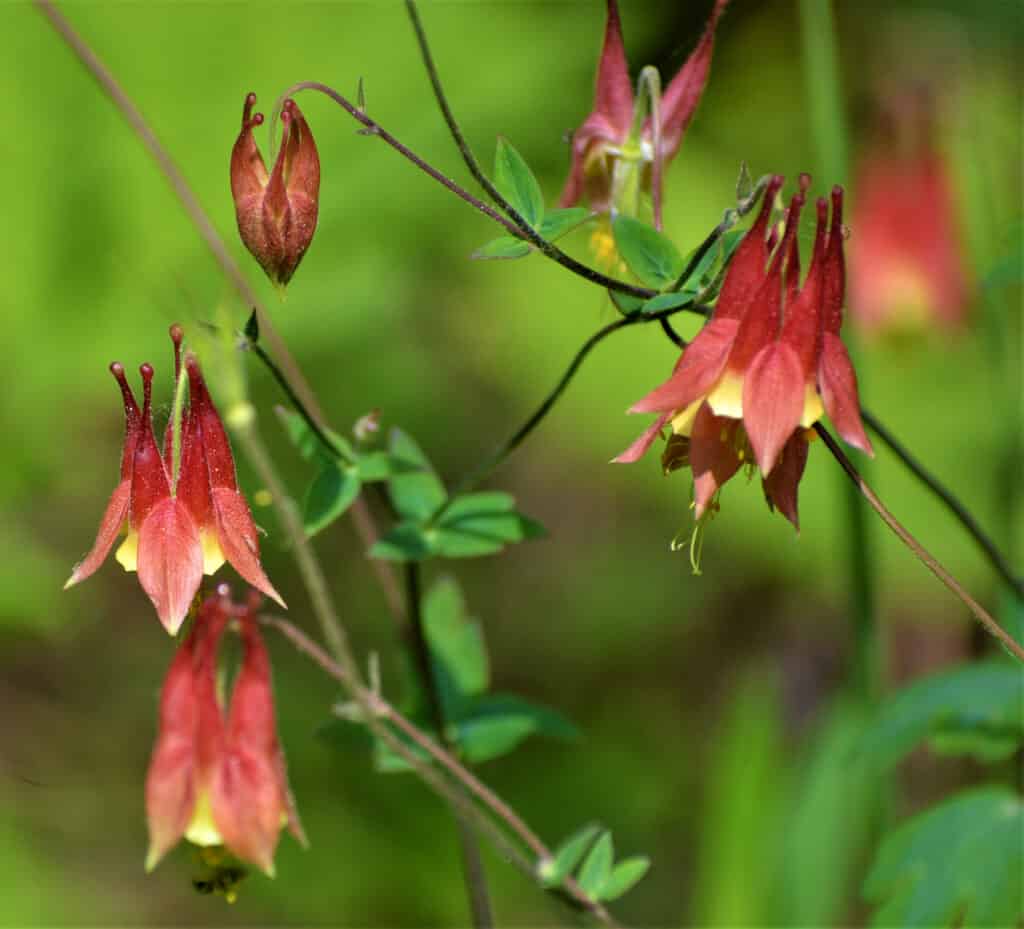
Red columbine’s erect stems grow 2 to 3 feet high and produce drooping, funnel-shaped red and yellow flowers.
©akslocum/Shutterstock.com
Other Perennial Flowers to Grow in Rhode Island
These are just seven of the best perennial flowers you could grow in Rhode Island. There are many others – from bee balm to garden phlox! This article is just the beginning. As you plant your perennial garden, consider the kind of flowers you hope to see, the sun and soil conditions in your lawn and garden, and how much care and attention you plan to give your plants. In addition to bee balm and garden phlox, a few other flowers you could plant are perennial sunflowers, stonecrop (sedum), speedwell, Shasta daisies, bleeding hearts, and many others.
Be sure to follow expert tips for gardening in Rhode Island and do your research into the other native plants in the state. When in doubt, you can always follow gardening best practices. For example, it is usually better to overwater than it is to underwater. If you see dead foliage or decaying plant matter, remove that. Let bumblebees and butterflies do their thing, but watch out for slugs and other pests that could devour your healthy flowering plants. Lightly fertilize, but be careful not to add too much fertilizer and “burn” your plants. Lastly, follow the guidelines for each of these flowers, but do not be afraid to adapt your plans for your own specific garden.
Summary of the Best Perennial Flowers for Rhode Island
In review, here is a list of the best perennial flowers for Rhode Island gardeners to plant this year!
| Number | Flower (Common Name) | Flower (Scientific Name) | Growing Conditions | Maintenance |
|---|---|---|---|---|
| 1 | Daylily | Hemerocallis spp. | Full sun, moist and well-drained soil | Low-maintenace, water weekly until established, mulch, and remove dead foliage in the spring. |
| 2 | Black-eyed Susan | Rudbeckia hirta | Full or partial sun, well-drained soil, spaced apart | Resilient, but must be treated carefully. Avoid watering the leaves, be careful to remove dead plant matter, and do not crowd the plants too close together. |
| 3 | Coneflower | Echinacea spp. | Full sun, well-drained soil, compost, spaced 1 to 3 feet apart | Resilient and drought tolerant, but need watering during dry spring seasons. |
| 4 | Coral Bells | Heuchera spp. | Partial shade to full sun, depending on the variety, well-draining and nutrient-dense soil | Resilient and tolerant of shade, but in need of consistently-moist soil. They are low-maintenance but may be a short-lived perennial. |
| 5 | Hosta | Hosta spp. | Full to partial shade, well-draining, nutrient-dense soil, spacing according to the variety | Shade-loving and tolerant of a range of conditions, and need moist soil that does not become overly damp. They are relatively low-maintenance and long-living. |
| 6 | Peony | Paeonia | Full or partial sun, well-draining, nutrient-dense soil, stakes to support the weight of the fluffy flowers | Peonies are easy to grow and can thrive in areas with well-draining soil, plenty of sunlight, and space away from trees or shrubs that will compete with the peony for water and nutrients. |
| 7 | Red Columbine | Aquilegia canadensis | Partial sun, well-draining or rocky/sandy soil | Low maintenance, water weekly until established, mulch, and remove dead foliage in the spring. |
The photo featured at the top of this post is © iStock.com/ananaline
Thank you for reading! Have some feedback for us? Contact the AZ Animals editorial team.






